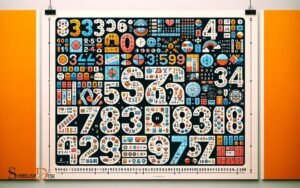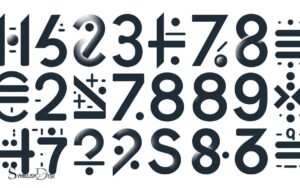Does Not Exist Math Symbol: Explain!
The “does not exist” symbol, denoted by ‘∄’, is an integral part of mathematical notation, signifying that a particular element or solution does not exist within a specified set or under certain conditions.
The ‘∄’ symbol is used in various branches of mathematics:
For example, stating “∄x ∈ ℝ such that x^2 = -1” translates to “There does not exist a real number x such that x squared equals -1.”
This symbol is pivotal in mathematical expressions, defining clear boundaries of possibility and existence.

Key Takeaway
Understanding the “Does Not Exist” Symbol in Mathematics
| Symbol | Meaning | Usage Example | Mathematical Field |
|---|---|---|---|
| ∄ | Does not exist | ∄x ∈ ℕ where x^2 = -4 (No natural number x) | Set Theory |
| ∄ | No limit exists | ∄lim(x→0) of 1/x (Limit does not exist at x=0) | Calculus |
| ∄ | Non-existence | ∄ person taller than the Eiffel Tower | Predicate Logic |
Origin and Development
The origin and development of the ‘does not exist’ math symbol can be traced back to the early developments in symbolic logic and set theory.
In symbolic logic, the concept of existential quantification, denoted by ∃, was introduced to express that there exists at least one element in a set that satisfies a given condition.
The negation of this statement led to the symbol ¬∃, indicating that there does not exist an element meeting the specified criteria.
This logical concept was further extended and formalized in set theory, where the symbol ∅, representing an empty set, came to be used to denote the absence of elements.
Over time, these foundational ideas converged, leading to the creation and widespread adoption of the ‘does not exist’ symbol ∄ in mathematics, providing a concise and precise notation for expressing the absence of solutions or elements within a given context.
Notation and Representation
Notation for expressing the absence of solutions or elements within a given context is a crucial aspect of mathematical representation.
In mathematics, the symbol “∅” is commonly used to represent the empty set, indicating the absence of any elements. This notation is essential for conveying the concept of a set with no members, which has significant implications across various mathematical disciplines.
Additionally, the use of the symbol “¬” in logical notation denotes negation, representing the absence of a particular condition or proposition.
Clear and precise notation for expressing absence allows for the accurate communication of mathematical concepts and the formulation of logical statements.
Understanding these notations is fundamental for effectively expressing the absence of solutions or elements within mathematical contexts.
This notation is foundational for its use in set theory, where the concept of an empty set plays a significant role in defining and understanding mathematical sets.
Use in Set Theory
In set theory, the symbol ‘∅’ plays a fundamental role in denoting the absence of elements within a given set. This symbol represents the empty set, which is a crucial concept in mathematics.
In set theory, the empty set is defined as the set that contains no elements. It is denoted by ‘{ }’ or ‘∅’. The empty set is a subset of every set, and it has unique properties that make it essential in various mathematical proofs and definitions.
For instance, it is used to represent the intersection of two disjoint sets, as the intersection of any set with the empty set results in the empty set itself.
Furthermore, the empty set is instrumental in defining the concept of a null set and is a fundamental building block in set theory.
Application in Limits and Continuity
Symbol ‘∅’ is frequently used in the context of limits and continuity in mathematics, serving as a key representation for the absence of elements within a set in these mathematical concepts.
In the study of limits, the symbol ‘∅’ is often utilized to denote the absence of a limit, indicating that the limit of a function does not exist at a particular point.
Similarly, in the context of continuity, ‘∅’ is employed to represent a discontinuity in a function, highlighting points where the function is not continuous.
This symbol plays a crucial role in conveying the non-existence of certain elements within the framework of limits and continuity, enabling mathematicians to precisely define and analyze these concepts.
| Application in Limits | Application in Continuity |
|---|---|
| Denotes absence of limit | Represents discontinuity |
Significance in Existential Quantification
The use of ‘∅’ in existential quantification provides a succinct representation of the non-existence of elements within a mathematical set, allowing for precise logical statements and reasoning.
Its significance lies in:
- Clear Representation: The symbol ‘∅’ unambiguously denotes the absence of any elements in a set, aiding in the clear articulation of mathematical concepts.
- Logical Inference: It enables mathematicians to express statements such as “there exists no x such that P(x)” concisely and rigorously.
- Set Theory: In set theory, the symbol ‘∅’ is fundamental in conveying the concept of an empty set, which has significant implications across various mathematical domains.
- Problem Solving: In problem-solving, the use of ‘∅’ allows for the explicit declaration of the non-existence of solutions, facilitating precise and efficient mathematical reasoning.
Absence in Solutions and Equations
How does the symbol ‘∅’ contribute to representing the absence of solutions and the non-existence of elements in mathematical equations? The symbol ‘∅’, also known as empty set or null set, plays a crucial role in denoting the absence of solutions in mathematical equations.
In set theory, the empty set represents a collection with no elements, signifying the absence of any solution or element within a specific context. When utilized in equations or set notation, ‘∅’ conveys the concept of there being no valid solution or element satisfying the given conditions.
Its presence allows mathematicians to explicitly express when a solution or element does not exist within a particular mathematical framework, thereby enhancing precision and clarity in mathematical discourse.
Symbol in Predicate Logic
The use of symbols in predicate logic is crucial for expressing logical statements and reasoning. Quantifiers, such as the universal and existential quantifiers, play a fundamental role in predicate logic by allowing us to make generalizations and assertions about entire classes of objects.
Additionally, the negation symbol in logic is essential for expressing the denial or negation of a statement, which is fundamental in constructing complex logical expressions.
Quantifiers in Predicate Logic
Quantifiers in predicate logic provide a means to express statements about the properties of objects within a specified domain. They are essential for forming precise and unambiguous statements.
Some important aspects of quantifiers in predicate logic include:
- Universal Quantifier (∀): Denotes that a statement holds for all elements in the specified domain.
- Existential Quantifier (∃): Indicates that there exists at least one element in the specified domain for which the statement holds.
- Scope: Specifies the extent to which the quantifier applies within a given logical expression.
- Bound and Free Variables: Bound variables are those within the scope of a quantifier, while free variables are not.
Understanding these quantifiers is crucial for effectively expressing logical statements about objects and their properties.
Negation Symbol in Logic
Discussing the negation symbol in logic (symbol in predicate logic) involves examining the complementary nature of logical statements and their implications within a specified domain.
In predicate logic, the negation symbol, often denoted as ¬ or ~, is used to express the opposite of a given statement. It is a fundamental element in constructing complex logical expressions and plays a key role in formal reasoning.
The application of the negation symbol allows for the formation of negated statements, enabling the expression of denial or contradiction within logical arguments.
Understanding the negation symbol is crucial for grasping the intricacies of predicate logic, as it forms the basis for quantified statements and logical operations.
Mastery of the negation symbol is essential for developing a strong foundation in logical reasoning and critical thinking.
Handling Non-Existent Values
When working with mathematical concepts, it is crucial to address the handling of non-existent values. Dealing with undefined values, managing null or NaN, and addressing missing data are all important considerations in mathematical and statistical analyses.
Understanding how to handle these non-existent values is essential for accurate and meaningful results in mathematical operations.
Dealing With Undefined Values
Dealing with undefined values in mathematics requires a precise understanding of the conditions under which these values arise and how to appropriately handle them.
When encountering non-existent values in mathematical expressions, the following guidelines can aid in effectively managing such situations:
- Identify the source: Determine the operation or expression that leads to the undefined value.
- Investigate the domain: Analyze the domain of the function or expression to comprehend where the undefined value originates.
- Consider limits: Explore the behavior of the expression as it approaches the undefined value to ascertain potential limits.
- Use alternative representations: Employ alternative forms, such as limits, piecewise functions, or transformations, to redefine the expression and resolve the issue of non-existent values.
Managing Null or Nan
Management of non-existent values in mathematics involves careful consideration of their impact on mathematical operations and functions.
When dealing with null or NaN (not a number) values, it’s crucial to handle them appropriately to prevent errors in calculations.
Special care is needed when performing arithmetic operations involving null or NaN, as they can propagate and affect the entire computation.
In some cases, specific mathematical functions may not be defined for null or NaN, requiring alternative approaches such as conditional checks or special handling routines.
Additionally, understanding the implications of null or NaN in mathematical models is essential for accurate interpretation and meaningful results.
Fortunately, various techniques and strategies exist for managing non-existent values, ensuring the integrity and reliability of mathematical analyses.
Addressing Missing Data
The proper handling of null or NaN values in mathematical analyses is critical for ensuring the accuracy and reliability of statistical interpretations and data-driven decision-making.
Addressing missing data involves employing appropriate techniques to mitigate the impact of non-existent values on the analysis. This is vital for maintaining the integrity of mathematical models and statistical inferences.
Here are four essential methods for addressing missing data:
- Imputation: Filling in missing values with substitutes based on existing data.
- Deletion: Removing records or variables with missing values from the dataset.
- Model-based methods: Using statistical models to estimate missing values.
- Multiple imputation: Generating multiple imputed datasets to account for uncertainty in the imputation process.
Conclusion
The non-existent math symbol has influenced set theory, limits, continuity, existential quantification, and predicate logic. Its absence in solutions and equations poses challenges in handling non-existent values.
Despite its absence, the symbol has played a significant role in mathematical development and notation. Its impact can be seen in various mathematical concepts and theories, showcasing its importance in the field of mathematics.






